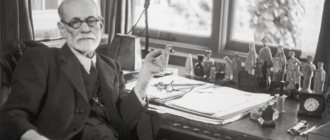From the publisher
This work opens a book series under the general title “MODERN PSYCHOANALYSIS”, which aims to introduce the reader to the main directions of psychoanalytic thought - its theoretical positions, applied developments and clinical practice. The need for an undertaking of this kind is dictated, first of all, by the urgent need of the thinking part of Russian society for a serious rethinking of the world psychoanalytic experience of recent decades and its inclusion in the general context of the domestic scientific and educational systems.
For various reasons, including ideological ones, the rich creative heritage of Freud’s closest students and followers, as well as the latest research by current psychoanalysts—many of the master’s own works, fortunately, at one time were published in Russian, although subsequently hidden in all sorts of “special storage” - they found themselves excluded from the scientific, clinical and cultural processes in Russia. This circumstance prompted our publishing house, along with the already published “Library of Analytical Psychology” series, to begin publishing books directly in the psychoanalytic series.
The practical task of “restorative” work of this kind, along with the publication of books of psychocentric and medical-centric directions in classical and postclassical psychoanalysis, is also the publication of a number of works that make it possible to clarify the psychopathological specificity of the totalitarian history of society as a medical history, within the framework of which a new fictional genre emerges. Historians, political scientists, and publicists have already made their feasible contribution to the creation of a kind of “circular frame” of the social history of Russia, but psychologists have yet to articulate the discursive articulation of our latest psychohistory, which would make it possible to reveal to society the difference between the history of the individual and social soul and the history of its illness. The mental, alas, is too often seen through pathology...
This project is the fruit of the efforts of many people, not only employees of the publishing house “B. S.K.” and the Information Center for Psychoanalytic Culture, which initiated the very idea of the publishing series, but also a number of other organizations.
In carrying out such a serious undertaking, we are constantly assisted by the International Psychoanalytic Association (IPA), the European Psychoanalytic Federation (EPF), a number of foreign publishing houses and foundations, in particular the German charitable foundation Inter Nations, the Russian Psychoanalytic Society and the Russian Psychoanalytic Association in Moscow, the Society for the Promotion of Modern art "A-Z" in St. Petersburg. We express our deep gratitude to all of them.
We are well aware of the difficult task we have undertaken. Therefore, we are grateful in advance to all our future readers for their critical advice and wishes.
January 1997
How is psychoanalysis performed?
The process of psychoanalysis consists of the study and reorganization of personality; This is done so that the individual can store his tensions with less difficulty until the time comes to release them. It is necessary to make the subconscious conscious and bring unsatisfied tensions under observation. It is believed that in order to be fully carried out, this process must last at least a year and consist of three to six sessions per week, each lasting about an hour. If the study lasts less than a year or the number of sessions is less than three per week, it is almost impossible to conduct the process effectively.
To conduct a psychoanalytic session, the patient lies on the couch, and the analyst sits in his head so as to be out of sight. Thanks to this, the patient’s psyche can work without distraction. In turn, this method relieves the doctor of unnecessary stress: without being under continuous observation, he can better concentrate on what the patient is saying.
The so-called free association method is used. This means that the free expression of the free flow of ideas is not restrained or changed by the usual censorship of consciousness (ideas of politeness, shame, self-respect).
In a state of free association, the patient's psyche is often filled with desires, feelings, reproaches, memories, fantasies, judgments and new points of view, and all this appears at first glance in complete disorder. However, despite the apparent confusion and incoherence, every utterance and every gesture has its own meaning in connection with one or another unsatisfied tension. Hour after hour, day after day, meanings and connections begin to emerge from the chaotic web of thoughts. Over a long period, certain central themes may gradually develop, relating to a number of tensions unsatisfied from early childhood, long buried in the subconscious and inaccessible to conscious recognition, which form the basis of the patient’s personality structure, the source of all his symptoms and associations.
9 pages, 4343 words
Methods for studying the psyche of children with intellectual disabilities.
... violations. Methods for studying the psyche of children with intellectual disabilities. Methods of psychological examination consist of methods of collecting information and methods of processing it. Collection...reflecting the possibilities of mastering the school curriculum, as well as the personality characteristics of the child. Analysis of psychopathological manifestations makes it possible to identify additional psychopathological...
The analyst's position in relation to the patient should be strictly neutral. The analyst's main job is, in a sense, to point out to the patient when he is deceiving himself; therefore, the doctor must always maintain a self-critical position, excluding any manifestations of sympathy and indignation towards the patient, which would give him the opportunity to deceive the doctor and himself. The analyst's unwanted emotional attitude toward the patient is called countertransference.
The question often arises: can psychoanalysis harm anyone? The greatest danger is to treat a patient on the verge of psychosis if the analyst is not aware of his true condition. The analyst must also be careful in distinguishing neuroses from certain brain diseases and hormonal disorders.
Based on materials from the book by E. Bern
4. What is hysteria from a psychoanalytic point of view? Her role in the discovery of psychoanalysis by Freud.
5. What are the methods of psychoanalysis? How do you understand talkingcure?
6. Expand the content of the concepts used by Freud: consciousness, unconscious, symptom, resistance, repression, sublimation. Show their relationship.
Preface to the Russian edition
Improving the political climate in the world helps restore broken international ties, eliminates prejudices in relations between states and social systems, and has a beneficial effect on the development of scientific knowledge, which should rightfully be attributed to psychoanalysis.
At one time, Russian psychoanalysis turned out to be one of the many victims of Bolshevism, and later German psychoanalysis became objectionable to the National Socialist regime. The dictatorial regimes that established themselves in Argentina and Chile had an equally depressing influence on the development of psychoanalysis in these countries.
Being not only a medical practice, but also a cultural theory, psychoanalysis is able to help better understand the historical dynamics of such political processes. This help may also consist in revealing aspects of shame and grief that previously had to be defended against, as well as in discovering latent prejudices and one’s own traits in the image of the enemy, which promises the possibility of positive social changes towards a multicultural society. For Germany, solving problems of this kind became especially urgent after the unification of the two German states in 1989.
The great world with its previously seemingly vast and endless expanses is now accessible not only to the imagination, but also, thanks to modern media, is completely visible.
Previously, individual nations independently chose one or another path of development; now they are in constant, multilateral interaction. Modern developments in systems theory convincingly indicate that not a single action in any country goes unnoticed for other countries and has certain consequences for them. We are talking not so much about causal processes with their inherent cause-and-effect relationships, but about circular processes, the slightest change in which affects the political system as a whole.
In such a socio-political context, the scientific community is also oriented not nationally, but multiculturally or internationally. At one time, psychoanalysis, which arose in Vienna, quickly crossed the borders of Austria and became the property of world culture...
The international spread and development of psychoanalysis led, however, not only to the destruction of barriers of misunderstanding, but to numerous splits, which began with differences in views between the three “pillars” of the psychoanalytic movement - Sigmund Freud, Alfred Adler and Carl Gustav Jung. Subsequently, contradictions haunted psychoanalysts in other countries, pulling in different directions not only socially oriented political critics, but also completely non-politicized clinical structures and psychotherapeutic institutions.
Russia was no exception on this path of disengagement. After the collapse of the Soviet Union, the unified Psychoanalytic Association also split into a number of regional associations. In May 1995, the Russian Psychoanalytic Association separated from the Russian (“Arbat”) Psychoanalytic Society (Moscow). There are two independent psychoanalytic structures in St. Petersburg: the East European Institute of Psychoanalysis and the St. Petersburg Psychoanalytic Society with the publishing Information Center for Psychoanalytic Culture. In Rostov-on-Don there is a “Rostov Psychoanalytic Association” and even in the distant Siberian city of Tomsk they are interested in modern psychoanalysis.
In this regard, there is every reason to believe that the book “Modern Psychoanalysis,” written in Germany in 1989 for the general public, will arouse interest in Russia.
As for the enthusiasm and pioneer spirit reigning in Moscow, St. Petersburg and Rostov, the author was convinced of this personally in 1994, 1995 and 1996. In this regard, one involuntarily recalls the enthusiasm with which in Germany, after the disaster of 1945, throughout the 50s, foreign psychoanalysts were welcomed as they returned psychoanalysis to their homeland. Just as Germany at one time benefited from contacts with psychoanalysts in Great Britain, Holland and the USA, Russian colleagues are gaining lost experience from contacts with Western psychoanalysts.
This book is an adapted introduction to a complex area of knowledge. The motivation for writing it was the lectures and seminars that I gave for twenty years at the University of Frankfurt. Students' questions forced me to look for precise answers, to clarify what was unclear, to try to eliminate contradictions and fill existing gaps. Although there is no scientific (positive) justification for the correctness of the theory and practice of psychoanalysis, nevertheless, the latter constantly justifies itself in practical life. Related disciplines such as sociology, pedagogy, psychotherapy and others also derive obvious benefits from psychoanalysis.
I would like to express my special thanks to Sergei Pankov and Valery Zelensky for their painstaking work in translating and editing the manuscript, Roland Knappe from the Kletg-Kott publishing house for providing the publication rights, the German Inter Nationses foundation for their generous financial support, and the St. Petersburg publishing house “B. S.K.” for his efforts in publishing the book.
A number of Moscow colleagues provided assistance at various stages of the publishing project. I am especially grateful to Marina Igelnik, Yakov Obukhov, Sergei Nazaryan and Aron Belkin.
I hope that the book will find its readers in Russia and will not only help their professional growth, but also bring them a feeling of greater completeness of their own existence.
PETER KUTTER, Stuttgart,
November 1996
Theory of psychoanalysis
The theory of psychoanalysis contains philosophical and psychological positions, is a method of studying the human psyche, and is used to diagnose various types of mental illnesses and their treatment.
The central concept of psychoanalysis is the “unconscious,” which underlies human life and guides his actions. Also, his behavior is influenced by various kinds of complexes that form in childhood and “libido” (sexual desire).
The scientist believed that what a person represses from consciousness does not disappear anywhere, but moves into the area of the unconscious and continues to influence future life, emerging under various masks. S. Freud examined in detail the structure of the human psyche and concluded that it consists of three elements:
- I (ego, das Ich),
- Super-ego (super-ego, das Űber Ich),
- It (Id, das Es).
This structure is comparable to an iceberg:
- in which, what is on the surface – superego.
These are conscience, morality, principles, duty, education, framework and norms of behavior established by society.
- The invisible part of the iceberg - unconscious.
These are instincts, suppressed desires, fears, complexes, sexual desire, everything that a person tries to hide from others.
- Ego
is located at the junction of two parts. The ego is the person himself, his personality, which acts depending on which part of him is stronger.
If the unconscious takes over in a certain situation, then a person follows his desires and instincts; if the super-ego takes over, then he acts as is right, as is accepted in society.
If a person succumbs to the unconscious and acts as he wants, and not as he needs, then remorse sets in, a super-ego begins to appear in the person, which, with a feeling of guilt, reminds him that he did wrong. And if an individual infringes on his desires and acts in accordance with duty and moral norms, the suppressed unconscious begins to manifest itself in various forms: dreams, slips of the tongue, slips of the tongue, mistakes, and in some cases manifests itself in the form of neuroses and mental illnesses. The Austrian scientist attached great importance to all errors and slips, believing that they were not accidental and were a manifestation of the unconscious.
One of the central concepts of psychoanalysis is “libido” - these are suppressed sexual instincts that can manifest themselves in something creative - creativity, sports, active social activities, or maybe in something destructive - war, terrorism, murder. Based on this concept, a great scientist, an outstanding athlete and a hired killer are people with a hugely developed libido who have transformed (sublimated) it in a certain direction. That is, sublimation is the direction of unspent sexual energy into some other activity, and the more such energy a person has, the more active he will be and will achieve better results.
As a result of the events of the First World War, S. Freud slightly adjusted his concept and identified two primary principles that manifest themselves both in the individual person and in the existence of society and the cosmos: life (eros) and death (thanatos). These concepts are manifested in the desire for creation and destruction, satisfaction of desires and self-destruction.
The Austrian scientist outlined his theory in detail in such works as: “The Interpretation of Dreams”, “Totem and Taboo”, “I and It”, “Introduction to Psychoanalysis” and others.
Quote We do not choose each other by chance... We meet only those who already exist in our subconscious.
Sigmund Freud
INTRODUCTION
Why is another introduction to psychoanalysis necessary?
We proceed from the fact that numerous introductions to psychoanalysis need clarification. In other words, some of them, such as the popular works of Charles Brenner (1967), Gustav Bally (1961), or Lawrence S. Kuby (1956), have already become outdated. In this regard, new works appeared on the book market: “Depth Psychology” by Siegfried Elhard (1971), “Fundamental Course of Psychoanalysis” by Sebastian Goppert (1978), “Introduction to the Doctrine of Neuroses and Psychosomatic Medicine” by Sven Olaf Hoffmann and Gerd Hohapfel (1984 ); excellent up-to-date overview of psychoanalysis by Wolfgang Mertens (1981), concise and accurate information on psychoanalysis from the Frankfurt Sigmund Freud Institute (Muck et al., 1974). Developments in the book market include the “Textbook of Psychoanalytic Therapy” by Helmut Thome and Horst Kächel (1985), the first volume of which (“Basic Provisions”), compiled in collaboration with many scientists, introduces not only the basic principles of psychoanalysis, but also sets out in detail the essence of such special concepts as transference, correspondence, displacement, primary interview and dream interpretation develops certain rules of psychoanalytic therapy, deeply and thoroughly reveals the paths of development and goals of psychoanalysis.
The Institute of Psychoanalysis at the Faculty of Psychology of the University of Frankfurt, where I have taught since 1974, has a large selection of psychoanalytic literature; This is a good help for psychology students who, along with the classical psychological disciplines - psychological diagnostics, clinical psychology, educational psychology - take exams in professional and organizational psychology, as well as in psychoanalysis. Some of the books listed are suitable for these purposes; some, as it turns out in the process of working with students, are often not suitable for educational purposes. A number of monographs have been written on individual exam topics that are studied within the framework of psychoanalysis (such as the theory of personality and the doctrine of diseases), the vast majority of which are too difficult for students.
Future psychoanalysts are unlikely to get by with a university education. Students of the main course (psychology) and a parallel course (psychoanalysis) can and should receive fundamental information about the theory and practice of psychoanalysis, personality theory, the doctrine of illnesses, the theory of mental disorders, psychoanalytic methods of treatment and counseling, as well as the countless possibilities of applying psychoanalysis to social life and politics, to literature and art, to anthropology and philosophy. For a long time, I was content to have students study at least one book in each of these areas in preparation for the exam, but this kind of workload turned out to be excessive (compared to other disciplines) due to the comprehensive nature of the subject matter.
This consideration became the starting point for my work on an introduction to psychoanalysis, which, on the one hand, would complement the condensed information of the books of Charles Brenner, Wolfgang Mertens and the group of authors of the Sigmund Freud Institute, and on the other hand, would not pretend to be a textbook, most of which written, strictly speaking, for practicing psychoanalysts. Examples of such textbooks include the fifth edition of Wolfgang Loch’s “Psychoanalytic Theory of Illness” and Helmut Thome and Horst Kächel’s “Textbook of Psychoanalytic Therapy.”
In thinking about the content of this book, I was primarily guided by the interests of the students who have attended my lectures and seminars at the University of Frankfurt since 1974. This is how a scientifically based introduction to psychoanalysis appeared, which is intended for a wide range of readers and at the same time can serve as a guide for those who work in the field of social psychology and medicine. All readers interested in psychoanalysis and psychology will receive the necessary information when reading the book, regardless of their own studies, be it social work, medicine, psychology or some other field of activity.
However, the book will be useful for both final year students and practicing psychoanalysts. It will allow them to get a general idea of the subject and refresh their memory of existing knowledge, and partly expand it.
The aims and contents of this book differ in many respects from my previous work Psychoanalysis—Evidence, Methods, Theory and Application (Kutter, 1984), in which I compared numerous articles of recent years. in order to trace what exactly in psychoanalysis justified itself and what did not. In addition, I touched on the most important aspects of psychoanalysis as a method and theory. As for the practical application of psychoanalysis, I considered only those aspects of it that interested me at that moment, in particular, the contribution of psychoanalysis to group therapy and to solving social problems.
This book will talk about something else. The material from which it arose were lecture and seminar notes that had crystallized so much during endless discussions with university students that they literally cried out to become a book.
Psychoanalytic therapy techniques
Free association method
Patients were asked to relax on a couch and say whatever came into their heads, no matter how absurd, unpleasant, or obscene it might seem by everyday standards. When this happened, it was found that powerful emotional drives carried the uncontrolled thinking towards psychic conflict. Freud argues that the first random thought contains just what is needed and is a forgotten continuation of the memory. Later he makes the caveat that this is not always the case. The fact that the thought that arises in the patient cannot be identical with the forgotten idea is fully explained by the mental state of the patient. During treatment, two forces act in the patient - one against the other: on the one hand, his conscious desire to remember what has been forgotten, on the other, resistance that prevents the repressed or its derivatives from returning to consciousness. If this resistance is zero or insignificant, then the forgotten appears in consciousness without any distortion. The stronger the distortion under the influence of resistance, the less similarity between the emerging thought - a substitute for the repressed and the repressed itself. Nevertheless, this thought must have at least some resemblance to what is being sought due to the fact that it has the same origin as the symptom. If the resistance is not too intense, then by this thought you can recognize what you are looking for. A random thought should relate to the repressed one as a hint.
Dream interpretation
When analyzing dreams, Freud considers it necessary to follow three basic rules:
1. Do not pay attention to the external content of the dream, regardless of whether it is understandable to the patient or seems absurd, clear or confused, since it still in no way corresponds to the desired unconscious.
2. Dreams should be divided into elements, each of which is examined separately. In this case, the patient is asked to “explain” each element of the dream with the first words that come to mind, that is, to freely associate. Thanks to this, with each individual element of the dream, a number of other - “replacement” - ideas are evoked, with the help of which it becomes possible to decipher the hidden meaning of dreams.
3. When analyzing dreams, the researcher must be patient and wait until the “hidden, primordial unconscious” arises on its own.
Analyzing the pictures that a person sees in a dream, the psychoanalyst encounters resistance, especially when it comes to phenomena that, from the patient’s point of view, are insignificant, irrelevant, or subjects that are indecent to talk about. Freud believes that it is precisely those thoughts that the patient tries to suppress that turn out to be the most important, decisive for opening the unconscious. The technique of psychoanalysis is a fusion of theory and experience and is purely individual for each doctor.
Interpretation
The purpose of interpretation is to make some unconscious mental event conscious so that we can better understand the meaning of that piece of behavior. Interpretation is usually limited to a single element, a single aspect. Having carefully worked through a given interpretation of an element, trying to reconstruct the history and sequence of events in which the element is included, we must do more than interpretation. We must reconstruct that part of the patient's life that went on as usual, surrounding the patient, which predetermined the appearance of this element.
The procedures of clarification and interpretation are closely intertwined. Very often the first leads to the second, which in turn leads to further clarification. The path from interpretation to understanding is referred to as the stage of careful elaboration. This is the path from insight, from the analyst's ability to penetrate into the patient's inner life, to the patient's understanding of himself. Of all the analysis procedures, thorough study is the most time-consuming. Sometimes it drags on for six months or more.
Resistance and Transfer Analysis
Resistance
- the patient’s internal forces, which are in opposition to psychoanalytic work and protect the neurosis from therapeutic influence. In form, it represents a repetition of the same defensive reactions that a person used in his everyday life. Resistance operates through the patient's ego, and although some aspects of it may be conscious, much of it remains unconscious. Its manifestation may be the patient’s silence, his posture, affects (anger, stubbornness, shame, etc.), avoidance of topics, skipping sessions, refusal to acknowledge the presence of dreams, or the statement that “there are topics that I don’t want to talk about.”
The psychoanalyst's task is to uncover how, what and why the patient resists. The immediate cause of such resistance is the unconscious avoidance of such painful phenomena as anxiety, guilt, shame, etc. A distinction is made between ego-syntonic resistance and resistance alien to the ego. In the first case, the patient usually denies the very fact of opposition and prevents its analysis; in the second, he feels that he is shunning resistance and is ready to work on it analytically.
Transfer - uh
then, according to psychoanalysis, the process of manifesting feelings towards the therapist, which are in fact a concentration of past feelings towards other people - primarily towards the patient’s immediate environment in childhood. “Transfer,” Freud wrote, “is a repetition, a new ‘edition’ of old, objective relations.” Its mechanism is that the patient subconsciously identifies the doctor with the objects of his pregenital sexual desires. In other words, it “transfers” the properties of his father and mother to him with all the ensuing consequences. Transference consists of experiencing emotions, impulses, attitudes, fantasies and defenses in relation to a certain personality in the present, which are inadequate in relation to it, since they are a repetition, a transfer of reactions formed in relation to significant persons at an early age.
Transference causes reciprocal feelings and reactions in the psychoanalyst, which Freud called countertransference.
The famous psychologist divided transference into positive and negative. In the case of the first, the patient experiences feelings for the analyst such as love, tenderness, trust, sympathy, interest, infatuation, admiration, respect, etc. Love is most often noted, especially if the analyst and the patient are of different genders.
Symboldrama (Katathymno-imaginative psychotherapy, Katathymic experience of images) is one of the areas of psychotherapy based on the principles of depth psychology, which uses a special method of working with the imagination in order to make visible a person’s unconscious desires, fantasies, conflicts and defense mechanisms, and transference relationships and resistance. Symboldrama promotes their processing both at the symbolic level and during a psychotherapeutic conversation. The symboldrama method is based on the theoretical basis of psychoanalysis. In this regard, the method is based on the analysis of the unconscious dynamics of actual conflicts.
Symboldrama was created by the outstanding German psychotherapist Hanskarl Leuner (1919-1996). As a metaphor, symbol drama can be described as “psychoanalysis with the help of images.” Symboldrama is effective in the treatment of neuroses and psychosomatic diseases, as well as in the psychotherapy of disorders associated with neurotic personality development.
The basis of symboldrama is fantasy in the form of images on a free theme (motive) or given by a psychotherapist. The psychotherapist performs an accompanying function.
The method is based on the concepts of classical psychoanalysis, as well as its modern development. The understanding of the symbolism of images and processes occurring in symbol drama is significantly enriched by turning to the theory of archetypes and the collective unconscious of K.-G. Jung, as well as to the method of active imagination he developed. From a phenomenological point of view, parallels can be traced with child play psychotherapy and Gestalt therapy. In technical terms, symboldrama is close to the elements of conducting a psychotherapeutic conversation according to K. Rogers and some strategies of behavioral therapy according to J. Wolpe. However, symboldrama is not a combination of related methods, but an independent, original discipline, many elements of which arose long before they appeared in other areas of psychotherapy. Symboldrama successfully combines the advantages of a rich range of psychotherapeutic techniques that occupy a polar position: classical and Jungian analysis, behavioral psychotherapy, humanistic psychology, Ericksonian hypnosis and auto-training.
H. Leiner offers the following as the main motives of symbol drama:
1. meadow , as the initial image of each psychotherapeutic session;
2. climbing a mountain to see a panorama of the landscape from its top;
3. following a stream up or downstream;
4. home inspection;
5. watching the edge of the forest and waiting for a creature to emerge from the darkness of the forest.
All motifs generally have a wide range of diagnostic and therapeutic applications. At the same time, there is a certain correspondence between each specific motive and some issues. We can also talk about the attribution of specific motives to the stages of child development, as well as the special effectiveness of certain motives in the case of certain diseases and pathological symptoms.
Sand therapy is one of the methods of psychotherapy that arose within the framework of analytical psychology. It is a way of communicating with the world and with oneself; a way to relieve internal tension, embody it on an unconscious-symbolic level, which increases self-confidence and opens up new paths of development. Sand therapy makes it possible to touch the deep, authentic self, restore your mental integrity, collect your unique image, picture of the world.
Sand therapy uses a standard size wooden tray (50 x 70 x 8 cm), sand, water and a collection of miniature figurines. The bottom and sides of sandboxes are usually painted blue, which allows them to simulate water and sky. The collection includes all possible objects that can only be found in the surrounding world. The figures used are real and mythological, created by man and nature, attractive and terrible. The use of natural materials allows you to feel a connection with nature, and hand-made miniatures allow you to accept what already exists. For the therapist, compiling a collection can be a creative and exciting process in itself.
This process differs from other forms of art therapy in its simplicity of manipulation, the possibility of inventing new forms, and the short existence of the created images. The possibility of destroying the sand composition, its reconstruction, as well as the repeated creation of new subjects, gives the work a certain kind of ritual. The creation of successive sand compositions reflects the cyclical nature of mental life, the dynamics of mental changes. No special skills are required here. Miniature figures, natural materials, and the ability to create three-dimensional compositions give the image additional properties, reflect different levels of mental content, and help establish access to preverbal levels of the psyche. When working in psychotherapy on disorders originating from early childhood, when the child could not yet speak, the visual image is very important.
Playing with sand as a way of child development and self-therapy has been known since ancient times. The malleability of sand awakens the desire to create a miniature picture of the world from it. A person acts in the sandbox as a creator - one life story changes another, following the laws of existence: everything comes and everything goes, there is nothing that is irreparably destroyed, just the old turns into something different, new. By repeatedly experiencing this sensation, a person achieves a state of mental balance.
Playing with sand is a natural and accessible form of activity for everyone. A person often cannot express his experiences and fears in words, and then playing with sand comes to his aid. Playing out the situations that worried him with the help of toy figures, creating a picture of his own world from sand, he is freed from tension. And most importantly, he gains invaluable experience in symbolically resolving many life situations, because in a real fairy tale everything ends well!
Observations by psychologists show that it is precisely the first joint games of children in the sandbox that can clearly show parents the characteristics of the behavior and development of their children. Parents see that the child is becoming overly aggressive or timid in communicating with peers - this may be a reason to think about the education system.
The effect of working with sand.
Firstly, the child’s desire to learn something new, experiment and work independently increases significantly.
Secondly, tactile sensitivity as the basis of “manual intelligence” is powerfully developed in the sandbox.
Thirdly, in games with sand, all cognitive functions (perception, attention, memory, thinking), as well as speech and motor skills, develop more harmoniously and intensively.
Fourthly, object-based play activities are improved, which further contributes to the development of role-playing games and the child’s communication skills.
Fifthly, sand, like water, is capable of “grounding” negative energy.
Ticket 26
"New Old Criticism" of Psychoanalysis
The impetus for writing this book was also the numerous critical articles that have appeared recently that take psychoanalysis into the crossfire of derogatory criticism that should literally destroy it. Twenty years ago, at a press conference for Psychotherapy Week in Lindau, in the presence of the annual guild of academic (mostly non-psychoanalytic) psychologists who gather here, one journalist predicted that in just ten years, “Freudian psychoanalysis” would lose all meaning and give way to place for such new directions in psychology as behavioral therapy, cognitive psychology and learning theory. In 1969, journalist Ruprecht Skaza-Weiss quoted in the newspaper Stuptarter Zeitung (No. 110, p. 37) the diagnosis of the famous Hamburg psychologist and psychotherapist Reinhard Tausch, which sounded like this: “Death in ten years.” The prophecies did not come true. Psychoanalysis has existed and continues to exist to this day, and has advanced in many ways. However, other areas of psychology do not stand still.
The situation in the field of psychotherapy and psychoanalysis has changed dramatically over the past ten years. Now they are no longer looking for an explanation of everything high and low in the human soul on the intricate paths of psychoanalytic interpretation, but, on the contrary, are placing emphasis on experimental and natural scientific methods, on a series of scientific experiments, thanks to which students of American colleges, as well as students of German psychological departments of universities, master everything a large number of reliable and serious analytical research methods. The consequence of this is the transition from a purely statistical approach to numerical estimates and the identification of deviation norms. Of course, in this way you can find out a lot of interesting details that... however, they have too little practical significance for therapy.
On the contrary, the theory and practice of psychoanalysis find application in everyday work, in psychoanalytic consultations, in psychotherapeutic and psychosomatic clinics, and in the work of freely practicing psychotherapists. It is a living, renewing organism. Critics blame psychoanalysis for its lack of scientific validity and poor effectiveness of treatment methods. But attempts to present psychoanalysis as “profound charlatanism”, as does Dieter E. Zimmer (1986), to prove, like Hans Jürgen Eysenck (1985), the complete ineffectiveness of its methods, or to characterize it as an anti-scientific theory - this is the overall message of Christoph T. Eschenröder’s book “Here Freud was wrong” (1984) - are unfounded simply because the results obtained by psychoanalytic means are verified by methods that are the opposite of psychoanalysis and are not applicable to unconscious processes.
Eysenck and other critics of psychoanalysis are excellent experts in the statistical methods of the psychology of perception, the psychology of learning and the psychology of memory. They are well aware of the psychology of cognition, the psychology of motivation and the psychology of emotions. Using these methods, however, they lose sight of just that. what psychoanalysis does, namely unconscious processes and how they occur in the “dark recesses of the soul” between an externally observed stimulus, on the one hand, and discharge, on the other. Critics of psychoanalysis deal with unconscious processes approximately in the same way as physicists would do if they decided to use the means of classical physics (mechanics, electronics) to answer the questions of modern theoretical physics, for example, the theory of the atomic nucleus.
In order not to respond to the polemical “Attack on the Empire of King Oedipus” (Der Spiegel, 1984) with an equally polemical presentation, the theory, methods and application of psychoanalysis should be clearly and scientifically substantiated, and in order to benefit from the fruits of this work, a certain impartiality is necessary. A reader who holds views opposed to psychoanalysis will most likely perceive this book as just another exposition of psychoanalytic theory. But if this book's unpretentious treatment of the subject makes even a few skeptics question their own position, then its main purpose will have been achieved.
Practice
About the project, research activities and practices of students of the National Research University Higher School of Economics Practice is the core of the master's program and is required for the formation of the professional “I” of students. As part of the practice, students work with clients who have applied for individual psychoanalytic counseling in the project “Center for Psychoanalytic Consulting and Psychotherapy” . Also, the MP “Psychoanalysis and Psychoanalytic Psychotherapy” successfully cooperates with the organization “Anti-Slavery”, whose students can receive free psychoanalytic counseling as part of practice with our students. During the practice, the skills of psychoanalytic individual counseling and psychotherapy are developed; the ability to independently collect and analyze information about a real client situation is formed, based on the principles, approaches and methods of applied psychoanalysis, as well as key psychoanalytic concepts; the ability to plan and implement strategies in relation to a client case is developed; skills to participate in the supervision process are formed.
Internship programs
Study practice program (approved by the Academic Council of the EP (Minutes No. 2.6-30.4-03_4 of June 30, 2019)
Practical internship program (Approved by the Academic Council of the EP (Minutes No. 2.6-30.4-03_3 of June 30, 2018)) (PDF, 565 Kb)
Practice is a mandatory section of MP training for a specialist and is a form of organizing the educational process, directly focused on the professional and practical training of students.
The following types of practices are provided:
- Constant practice of consultative and psychoanalytically oriented psychotherapeutic work with clients/patients , which the program independently selects for students.
- Each session with a client/patient must be supervised in a group and/or individually with program supervisors.
- Pathopsychological workshops in specialized institutions.
Pathopsychological workshops
- The pathopsychological workshop at the Scientific Center for Mental Health of the Russian Academy of Medical Sciences opens up to students of the “Big Psychiatry” program.
- Pathopsychological workshop at the International Institute of Psychosomatic Health. Students of the program participate in a real pathopsychological examination and take an active part in clinical conversations and analysis of cases of patients of the Institute.
- Workshop of the Center for Psychological Assistance to the Population, students participate in the analysis of transcripts of consultation material on topics. Seminar - training on conducting short-term consultations and providing psychological first aid.
Professional Supervision Program
When implementing this educational program, it is mandatory to undergo a special type of professional practice - supervision, which involves organizing the practical activities of the student under the guidance of a highly qualified psychoanalyst or psychoanalytic psychotherapist. Supervision is carried out in group form.
Supervision of psychoanalytically oriented practice is not just mandatory, but a key component of the training of psychoanalytic consultants and psychotherapists. The program is implemented as follows: students carry out consulting or psychotherapeutic work in the appropriate bases, which is carried out under the constant supervision of MP specialists.










